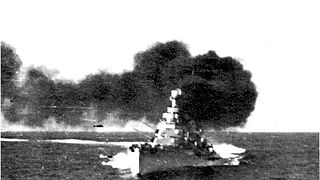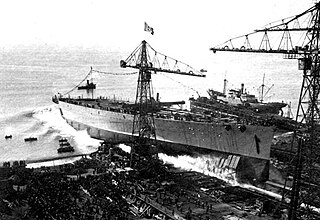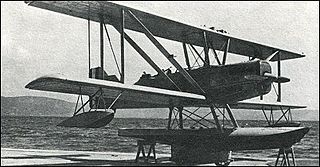
The Battle of Cape Spartivento, known as the Battle of Cape Teulada in Italy, was a naval battle during the Battle of the Mediterranean in the Second World War, fought between naval forces of the Royal Navy and the Italian Regia Marina on 27 November 1940.

The Zara class was a group of four heavy cruisers built for the Italian Regia Marina in the late 1920s and the early 1930s. The class comprised the vessels Zara, Fiume, Gorizia, and Pola, the last of which was completed to a slightly different design. The ships were a substantial improvement over the preceding Trento-class cruisers, incorporating significantly heavier armor protection at the cost of the very high speed of the Trentos. They carried the same main battery of eight 203 mm (8.0 in) guns and had a maximum speed of 32 knots. Among the best-protected heavy cruisers built by any navy in the 1930s, the heavy armor was acquired only by violating the terms of the Washington Naval Treaty, which limited cruiser displacement to 10,000 long tons (10,160 t).

The Trento class was a group of two heavy cruisers built for the Italian Regia Marina in the late 1920s, the first such vessels built for the Italian fleet. The two ships in the class—Trento and Trieste, were named after the redeemed cities of Trento and Trieste annexed from the Austro-Hungarian empire after the victory in World War I. The ships were very lightly armored, with only a 70 mm (2.8 in) thick armored belt, though they possessed a high speed and heavy main battery of eight 203 mm (8 in) guns. Nominally built under the restrictions of the Washington Naval Treaty, the two cruisers nevertheless exceeded the displacement limits imposed by the treaty.

The Second Battle of Sirte was a naval engagement in the Mediterranean Sea, north of the Gulf of Sidra and southeast of Malta, during the Second World War. The escorting warships of a British convoy to Malta held off a much more powerful squadron of the Regia Marina. The British convoy was composed of four merchant ships, escorted by four light cruisers, one anti-aircraft cruiser and 17 destroyers. The Italian force comprised a battleship, two heavy cruisers, one light cruiser and ten destroyers. Despite the initial British success at warding off the Italian squadron, the Italian fleet attack delayed the convoy's planned arrival before dawn, which exposed it to intense air attacks that sank all four merchant ships and one of the escorting destroyers in the following days.

Vittorio Veneto was the second member of the Littorio-class battleship that served in the Italian Regia Marina during World War II. The ship's keel was laid down in October 1934, launched in July 1937, and readied for service with the Italian fleet by August 1940. She was named after the Italian victory at Vittorio Veneto during World War I, and she had three sister ships: Littorio, Roma, and Impero, though only Littorio and Roma were completed during the war. She was armed with a main battery of nine 381-millimeter (15.0 in) guns in three triple turrets, and could steam at a speed of 30 knots.

Giovanni delle Bande Nere was an Italian light cruiser of the Giussano class, which served in the Regia Marina during World War II. She was named after the eponymous 16th-century condottiero and member of the Medici family. Her keel was laid down in 1928 at Cantieri Navali di Castellammare di Stabia, Castellammare di Stabia; she was launched on 27 April 1930, and her construction was completed in 1931. Unlike her three sisters, the finish and workmanship on the vessel were not rated highly. She was sunk on 1 April 1942 by the British submarine HMS Urge.

Zara was a heavy cruiser built for the Italian Regia Marina, the lead ship of the Zara class. Named after the Italian city of Zara, the ship was built at the Odero-Terni-Orlando shipyard beginning with her keel laying in July 1928, launching in April 1930, and commissioning in October 1931. Armed with a main battery of eight 8-inch (200 mm) guns, she was nominally within the 10,000-long-ton (10,000 t) limit imposed by the Washington Naval Treaty, though in reality she significantly exceeded this figure.

Bartolomeo Colleoni was an Italian Giussano-class light cruiser, that served in the Regia Marina during World War II. She was named after Bartolomeo Colleoni, an Italian military leader of the 15th century.

Trieste was the second of two Trento-class heavy cruisers built for the Italian Regia Marina. The ship was laid down in June 1925, was launched in October 1926, and was commissioned in December 1928. Trieste was very lightly armored, with only a 70 mm (2.8 in) thick armored belt, though she possessed a high speed and heavy main battery of eight 203 mm (8 in) guns. Though nominally built under the restrictions of the Washington Naval Treaty, the two cruisers significantly exceeded the displacement limits imposed by the treaty. The ship spent the 1930s conducting training cruises in the Mediterranean Sea, participating in naval reviews held for foreign dignitaries, and serving as the flagship of the Cruiser Division. She also helped transport Italian volunteer troops that had been sent to Spain to fight in the Spanish Civil War return to Italy in 1938.

Trento was the first of two Trento-class cruisers; they were the first heavy cruisers built for the Italian Regia Marina. The ship was laid down in February 1925, launched in October 1927, and was commissioned in April 1929. Trento was very lightly armored, with only a 70 mm (2.8 in) thick armored belt, though she possessed a high speed and heavy main battery of eight 203 mm (8 in) guns. Though nominally built under the restrictions of the Washington Naval Treaty, the two cruisers significantly exceeded the displacement limits imposed by the treaty.

Bolzano was a unique heavy cruiser, sometimes considered to be a member of the Trento class, built for the Italian Regia Marina in the early 1930s, the last vessel of the type to be built by Italy. A modified version of the earlier Trento class, she had a heavier displacement, slightly shorter length, a newer model of 203-millimeter (8.0 in) gun, and a more powerful propulsion system, among other differences influenced by the Zara class that had followed the Trentos. Bolzano was built by the Gio. Ansaldo & C. between her keel laying in June 1930 and her commissioning in August 1933.

Impero was the fourth Littorio-class battleship built for Italy's Regia Marina during the Second World War. She was named after the Italian word for "empire", in this case referring to the newly (1936) conquered Italian Empire in East Africa as a result of the Second Italo-Abyssinian War. She was constructed under the order of the 1938 Naval Expansion Program, along with her sister ship Roma.

The Meridionali Ro.37 Lince was a two-seater Italian reconnaissance biplane, a product of the Industrie Meccaniche Aeronautiche Meridionali (IMAM) company. It appeared in 1934 and had a composite structure of wood and metal. The aeroplane first saw operational duty in the Second Italo-Ethiopian War (1935–1936) and Spanish Civil War (1936–1939), and during the Second World War it saw duty on almost all fronts, except for Russia and the English Channel. It followed the Ro.1 as the main reconnaissance aircraft for the Italian Army.

The Piaggio P.6 was an Italian catapult-launched reconnaissance floatplane designed and built by Piaggio for the Regia Marina.
Operation White was a British attempt to deliver fourteen aircraft, twelve Hawker Hurricane fighters and two Blackburn Skua dive bombers, to Malta from the old aircraft carrier HMS Argus. White was one of what became known as Club Runs that supplied fighters for the defence of Malta. The operation was thwarted by the presence of the Italian fleet, which prompted the premature dispatch of the fighters; combined with bad weather and some poor navigation, this lefd to only five aircraft reaching Malta, all but one the other pilots and aircraft being lost at sea.

Pola was a Zara-class heavy cruiser of the Italian Regia Marina, named after the Italian city of Pola. She was built in the Odero Terni Orlando shipyard in Livorno in the early 1930s and entered service in 1932. She was the fourth and last ship in the class, which also included Zara, Fiume, and Gorizia. Compared to her sisters, Pola was built as a flagship with a larger conning tower to accommodate an admiral's staff. Like her sisters, she was armed with a battery of eight 203-millimeter (8.0 in) guns and was capable of a top speed of 32 knots.

Fiume was a Zara-class heavy cruiser of the Italian Regia Marina, named after the Italian city of Fiume, she was the second of four ships in the class, and was built between April 1929 and November 1931. Armed with a main battery of eight 8-inch (200 mm) guns, she was nominally within the 10,000-long-ton (10,000 t) limit imposed by the Washington Naval Treaty, though in reality she significantly exceeded this figure.

The Macchi M.71 was an Italian flying boat fighter of the 1930s designed and manufactured by Macchi.
The CANT Z.504 was a prototype reconnaissance biplane flying boat made by CANT in the 1930s.
The IMAM Ro.26, sometimes called the Romeo Ro.26, was a single-engine biplane trainer aircraft produced by the Italian aeronautical company IMAM in the early 1930s. Only one example was built.
















